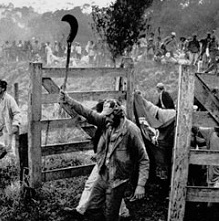
Brazil’s Landless Workers Movement (MST), one of the longest standing and largest social movements in Latin America, continues to be a relevant force in the lives of everyday communities and families.
![]()
Brazil’s Landless Workers Movement (MST), one of the longest standing and largest social movements in Latin America, continues to be a relevant force in the lives of everyday communities and families. The MST has three objectives, a continued struggle over land, a “people’s land reform” that is implemented nationally, and the transformation of civil society. Their purpose is not singular, and though their close attempts at a relationship with the Workers Party (PT) has brought them much criticism, their politics remain rooted in practice.
In the early months of 2015, a series of protests and demonstrations emerged against the PT regarding the Lava Jato corruption scandals and to shift political “alliances between influential groups and… political funding.” Protests with much less coverage have highlighted the party’s increasingly neoliberal attacks on the working class.
The MST has its critiques of the PT and the current administration of Dilma Rousseff, specifically for not making due on their promises for land reform and for having less support for legal settlements, while investing more in agribusiness and large agricultural industries. However, the MST did not participate in anti-Dilma or pro-impeachment demonstrations particularly because of the right wing nature of these protests and their attendance of mostly upper middle class people. Instead they have focused some of their energy on new land occupations, reinvigorating their community base support and their understanding of a landless people’s movement.
To be landless in Brazil is not understood simply as a social condition or an identity for the marginalized. To define one’s self as landless implies agency and a commitment to a community made up of active subjects that are working towards the construction of their own history. This category of the landless has been transformative for the everyday lives of those involved. As opposed to an individualized struggle for property ownership, the landless of Brazil see themselves as a collective subject firmly standing against multiple levels of material, ideological, and physical violence. This movement navigates a landscape of misinformation by media, displacement by military police, attacks by landowners and growing right-wing militias, in addition to the dismissive attitude of government officials.
The struggle of the MST is both political, pedagogical and a challenge to western notions of private property and land ownership. They have extensive networks of educators in charge of political formation through a pedagogia de la terra or pedagogy of the land, which draws heavily from scholars and militants like the well-known philosopher Paulo Freire. They are best known for occupying unused land, but their actual process to negotiate and acquire the land legally is less known. Those who identify as “landless” are not only MST; there are multiple organizations whose objective is land reform and land acquisition for the dispossessed. Some have subtle ideological differences, while others are divided by party lines.
The lands the MST occupies are carefully selected. The coordinating leadership investigates the areas, carefully looking at who the owners are, which political and social agents exist, other projects and networks that they are linked to, and of course, where the money is going and coming from. Land concentration in Brazil is one of the biggest issues that the MST is struggling to combat. Wealthy landowners, politicians, businesspeople and increasingly agribusiness that have the resources to purchase massive farmlands industrial agricultural production are typically not interested, and strongly resist, being forced into a negotiation.
Once the initial occupation has begun the MST forces a negotiation. The process is long and tedious. It often takes several years to negotiate a settlement; there have been families who have waited from two to twelve years to come to an agreement with Brazil’s National Institute for Colonization and Agrarian Reform (INCRA) and the landowners. INCRA is the government institution in charge of settling these “land disputes.” After several years of negotiation INCRA facilitates payment to the landowner using federal funds, the landless families agree to pay them back after a number of years through profits made through small scale agricultural production. This delay, however, leaves landless people in a precarious position, where many are susceptible to violence, harassment and discrimination. Violence on these occupied lands has increased, and many of the landless say that there is an increase in militias and paramilitaries that are organized to protect the landowners and what they consider private property.
Overall, the biggest obstacle for the landless is government bureaucracy and unfulfilled promises. Yet their unique challenge, one that has helped make them the region’s largest social movement, is to look within the MST and place their expectations beyond the limitations of an electoral process that some argue “has died in the most shameful way possible, buried by accusations of cynicism, venality, and corruption.”
As April 2015 comes to a close, the MST are completing “Abril Vermelho” (Red April) in commemoration of the Eldorado dos Carajas Massacre in 1996, which left 21 MST members killed. They use this moment to increase their visibility and the numbers of land occupations. Though their challenges remain, the MST continues to push forward in their efforts toward land reform and what they consider a transformation of civil society.
Armando Carmona is a freelance journalist and an editor at upsidedownworld.org
